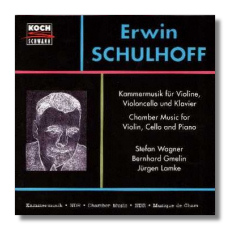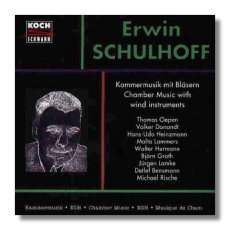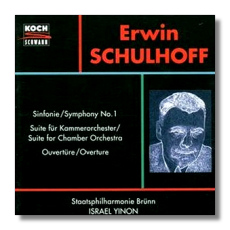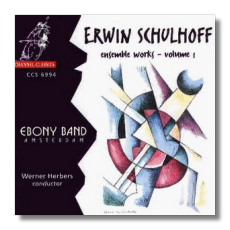
The Internet's Premier Classical Music Source
Related Links
- Schulhoff Reviews
- Latest Reviews
- More Reviews
-
By Composer
-
Collections
DVD & Blu-ray
Books
Concert Reviews
Articles/Interviews
Software
Audio
Search Amazon
Recommended Links
Site News
 CD Review
CD Review
Ervín Schulhoff

Chamber Music for Violin, Cello, and Piano
- Duo for Violin and Cello
- Sonata for Violin & Piano #2
- Sonata for Cello & Piano
Stefan Wagner, violin
Bernhard Gmelin, cello
Jurgen Lamke, piano
Koch 3-1167-2


Chamber Music with Wind Instruments
- Concertino for Flute, Viola and Bass
- Divertissement for Oboe, Clarinet & Bassoon
- Sonata for Flute & Piano
- Hot-Sonata
Thomas Oepen, Volker Donandt, Hans-Udo Heinzmann,
Malta Lammers, Walter Hermann, Björn Groth,
Jürgen Lamke, Detlef Bensmann, Michael Rische
Koch 3-1232-2


Orchestral Works
- Symphony #1
- Suite for Chamber Orchestra
- Overture "Festive Prélude"
Staatsphilharmonie Brünn/Israel Yinon
Koch 3-1437-2


Ensemble Works - Volume I
- Le Bourgeois gentilhomme
- Tangos #1-3
- Konzert für Streichquartett und Bläser
Ebony Band/Werner Herbers
Channel CCS6994


Tanz Grotesk
- Franz Schreker: Geburtstag der Infantin
- Ervín Schulhoff: Der Mondsüchtige
- Paul Hindemith: Der Dämon
Gewandhaus Orchestra Leipzig/Lothar Zagrosek
London 444182-2
More than fifty years after his death in the Wulzburg concentration camp, Czech composer Ervín Schulhoff is finally getting recognized. At least five record companies are releasing selections from his works and his chamber music is appearing in the repertoire with other composers of "Entartete Musik" (degenerate music) from the Nazi era. Within thirty years, he wrote sonatas, quartets, sextets, jazz piano pieces, stage music, an opera, eight symphonies, and at least one oratorio. Unlike France's Les Six, his Workshop of the Time held regular meetings, exchanged ideas, and stood with him "on the threshold of the land of the future, wretched and defiant." He readily absorbed influences from members of the Second Viennese school like his friend Artur Schnabel, but never became one of them. Like Paul Hindemith and Leoš Janáček, he went his own way, affected by trends, yet not dominated by them. He changed often in his short life, flipping back and forth between styles as if plagued (or blessed) by multiple personalities. Perhaps there was not one Ervín Schulhoff, but four.
Schulhoff #1 wrote a cello sonata in 1914 (Koch 3-1167-2). This piece could be heard as a charming pastiche of Max Reger, Claude Debussy, and Gustav Mahler, if it weren't so unrelentingly serious. Lush keening tones rise and descend, as the cello conveys intense yearning and nostalgia for late Romanticism. It is a well-executed academic piece by an impetuous 20-year old, eager to show the world he's mastered repeats, imitation, variation, and counterpoint. Cellist Bernhard Gmelin and pianist Jürgen Lamke do an admirable job on this odd work, although they could have played the presto with more brio.
On the same disc is Violin Sonata #2, written thirteen years later. Schulhoff #2 has appeared and has gleefully shed his snakeskin of schmaltz. This trim and exhilarating piece employs a welter of new tricks, undoubtedly gleaned from Béla Bartók (whose violin sonatas appeared five years earlier): stunning pizzicatos, strategic dissonance, otherworldly fades, and just enough high-register violin passages to give it a raw edge. The last piece on this disk, the Duo for Violin and Cello, also takes outrageous risks and gets away with them. A contemplative moderato suddenly erupts into a frantic vivace, presaging the next movement's rhapsodic Hungarian Zingaresca (gypsy dance). Then, just as quickly, it fades into pianissimo. Violinist Stefan Wagner and pianist Lamke seize this piece like a gold kroner and run off with it.
Schulhoff's resonant music for winds reflects the turbulent times in which they were written. His 1930 Concerto for String Quartet and Winds (Channel CCS 6994) immediately states its business with no introduction or development, much like Hindemith's Kammermusik #1 written a few years earlier. Its clashing tones are harsh and angular like a painting by New Objectivity artist Otto Dix, whom Schulhoff knew personally. All traces of romanticism, even satirical ones, are absent. The strings openly compete with the winds, melodies traverse the scale with ascending urgency as if being timed by a stopwatch. Even the largo movement is in a hurry to state its themes. At times the horns blare harshly against a soothing string figure, other times they play snatches of jazzy rhythms, yet never quite cutting loose. This is the music of the twenties, an anthem of exultation and confusion, of runaway inflation and late-night carousings. Conductor Werner Herbers leads the Ebony Band in a competent live recording that doesn't draw attention to itself. The musicians sound like they're crammed in a smoky cafe.
The Concerto for Flute, Viola, and Double Bass (Koch 3-1232-2) is a more complex piece. After opening with a sweet nostalgic melody, it soon mutates into an edgy disturbed dialog between the flute and the bass. Other melodies appear and retreat, varying tempi and intensities. All is not well in Schulhoff's 1925 Prague. When the nostalgic melody returns at first movement's end, the coda feels cynical, like a dream betrayed. As contrast, the second and fourth movements are filled with lively Bohemian dance strains that, like the Slavonic dances of fellow countryman Antonín Dvořák, pass right through you with ephemeral sweetness. Sandwiched between them is an uncertain andante that hearkens back to the spirit of lost romanticism. Somehow Shulhoff pulls all of this together into an entertaining and thoughtful piece. On the same disc, the Sonata for Flute and Piano opens as an atmospheric mood piece, languid background music for a quiet evening at the salon. But an energetic scherzo and rondo intrudes, with the piano playing daring obbligatos with the sprightly flute. While not a whimsical piece, this sonata plays tricks on listener expectations, lulling them one moment and jostling them the next. It's a small masterpiece.
The Dada movement of the early twenties shook the foundation of the complacent European art world. Artists responded to the horrific aftermath of World War I with irreverence, humor, and shock effects – "slaps in the face of public taste." Schulhoff #3 gleefully joined this movement and instantly turned into one of Dada's musical exponents. "I became a grotesque, a burlesque, a humoresque," he said. In 1926 the Czech National Theatre awarded him a commission to write the stage music for Moliere's Le Bourgeois Gentilhomme, which was to be given the full Dadaist treatment. The resultant stage music (Channel CCS 6994), after a noisy mock-heroic overture, presents a stunning grand ballet with a seething tango and satiric musical portraits. Rapid-fire xylophones and off-key horns contribute to its madcap aura. Shepherds, philosophers, critics, and boxers parade onstage, each tagged with amusing leitmotifs. A few years earlier, Schulhoff had become enchanted by artist George Groz's collection of American jazz records. The 1921 Suite for Chamber Orchestra (Channel CCS 6994) is his first successful attempt to compose a jazz piece for orchestra. Consisting of six dances with names like "Ragtime," "Valse Boston," and "Shimmy," this bouncy, often silly work features instruments never used in the classical repertoire before, like slide whistles and car horns. "Step" is a forty-eight second miniature featuring only percussion instruments. The suite combines bitonality and harsh dissonances with the melodic style of contemporary music. Like others of his generation (Kurt Weill, Igor Stravinsky), Shulhoff loved the tango and inserts one into this piece. Expertly conducted by Herbers' Ebony Band, it is a well-scored, slinky departure from the humoresques; however, the version conducted by Israel Yinon (Koch 3-1437-2) is less bouncy. Compared with Herber's performance, this one suffers from inhibited tempo and precious little sense of risk, particularly in the opening movement. Instead of seething with sex, the tango glides like a stately minuet. Perhaps disheartened by the public's cool reception, Schulhoff recycled the suite four years later into a ballet called Moonstruck (London 444 182-2), expertly connecting the dance tunes into a more dramatic - although less funky - presentation (trumpets instead of car horns!). Conductor Lothar Zagrosek leads the Gewandhaus Orchestra Leipzig in a slick competent reading.
Schulhoff's Hot Sonata for Alto Saxophone and Piano (Koch 3-1232-2) is his most mature jazz piece. Marked by strong rhythms and a guffawing saxophone that almost sounds improvised, this piece is George Gershwin on absinthe. Saxophonist Detlef Bensmann plays a languorous legato as well as a wailing arpeggio in masterful syncopation to Lamke's piano riffs. Schulhoff once boasted to his publisher that he was the inventor of "classical jazz." With this piece, he may be the first classical-jazz fusionist, skillfully blending an upbeat expressionist tempo with neo-classical precision. Modern fusionists like Stanley Myers and Richard Rodney Bennett continue this tradition in their saxophone concertos.
In the 1930s Schulhoff #4, like many artists from that era, plunged into political radicalism and became a communist. Most critics believe that his music from this era suffered from the simplifying effects of socialist realism. Schulhoff claimed a few years later that he had abandoned "formalist fooling around and the musical frivolity" of his earlier years. He responded to his conflicted era by writing a massive oratorio based on the text of the Communist Manifesto. While no recording yet exists in the Schwann catalog, it's intriguing to speculate about such a bizarre undertaking. Could it be like Dimitry Shostakovich's rousing cantata The Execution of Steka Razin or perhaps be just an intriguing oddity, like Alexander Mosolov's clanging Iron Foundary ballet?
The complete symphonies have also yet to be released, but Symphony #1 (Koch 3-1437-2) gives some indication of the direction Schulhoff was pursuing. Like Hindemith's Mathis der Maler symphony, this composition plunges into towering themes of struggle and redemption. Brash motives rise and build toward swelling climaxes, subsiding only to rise again in harsh dialectics of sound. Doubt and sadness pervade the andante, but not for long. A march tune begins, eerily similar to the one in Shostakovich's Seventh Symphony. It flirts with dissonance, then resolves into a light mode, buoyed by xylophones, celestas, and flexatones. With cleverly placed ostinati and thematic recapitulations, Symphony #1 is an exciting, well-balanced work, passionately conducted by Israel Yinon. A departure from Shulhoff's chamber music, the piece does lack irreverance, irony, and the spirit of innovation. And although Schulhoff maintained that it was "filled neither with pathos or heroism," it bears the stamp of gebrauchtmusic (work written for a large public) and enjoyed brief international popularity after its Cincinnati and London performances. Critics even suggested he turn it into a ballet or pantomime. Although an intriguing work, it does not dazzle with repeated listenings, like Bartók's ferocious First Piano Concerto, with which it premièred.
The jury is still out on Schulhoff #4, due to lack of evidence. Record companies are still testing the waters. How the public responds to this brilliant and quirky composer will determine when we finally hear his complete works.
Copyright © 1997, Peter Bates



















